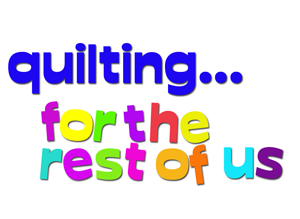As I've mentioned, I've been doing a lot of reading on design principles and the like. Lately, I've been reading Color Magic for Quilters by Ann Seely and Joyce Stewart. Now, there are a ton of books out there on color for quilters. I just happen to be using this one. I'll do a full review on an upcoming episode of my podcast. But for now, suffice it to say that the book spends a chapter on each color scheme of the color wheel and talks about applying it to quilts. And it goes far beyond the usual monochromatic, analagous, split-complementary and other schemes we're used to seeing in these kinds of books.
I started with greens. This one took me awhile to find a set I thought might actually work. My stash of greens didn't want to play nicely together for some reason.
I don't think there's quite enough variety of scale of print in this one. Not my favorite, but it could work.
The blues feel a little more successful because I have a wider variety of scale of print, and some of the blues are less muted than the greens were, so there is more variation of saturation (if that's the right term).
The blues were a little more social. It didn't take me as long to find a set that I could easily see being made into a quilt.
I thought I'd play with it, and suggest you play too. What I'm doing to do is go through the color schemes in the book, one per week (on Tuesdays), and see if I can pull fabrics from my stash that might fit that scheme. So each week, I'll imagine, "If I were to make a quilt entirely from my stash using this scheme, what might that look like?
And then I'll post a linky on that blog post for you to do the same--once you see the color scheme of the week, try it for yourself and link up to my blog with your attempts. If you have tiny stashes, go ahead and use EQ or something like that--but it is important to use actual fabric or fabric images. It's much harder that way than just putting some plain colors onto a computer monitor!
So, this week we're starting with one color. Color Magic refers to this as "single color harmony," and, of course, it's more widely known as monochromatic.
Monochromatic use a single color--but you can use shades, tints, and tones within that color. You can also add neutral fabrics if you'd like--white, gray, black, for example, don't add actual (technical) color to a monochromatic scheme so they're legal, if you like to think in those terms.
Contrast and scale are crucial here. If all of your fabrics are the same value and all the same scale of print, it'll most likely be a less exciting quilt than if you're able to have nice contrast, and a nice contrast of scale as well (large prints, small prints, "read-as-solids," etc.).
Play time.
BTW, I had to work very hard to find prints that had no other colors in them. That was probably the trickiest part. (A multi-colored print is no longer monochromatic, right? At least, if we're being legalistic about it, which for the purposes of this play time I chose to be.)
I don't think there's quite enough variety of scale of print in this one. Not my favorite, but it could work.
The blues feel a little more successful because I have a wider variety of scale of print, and some of the blues are less muted than the greens were, so there is more variation of saturation (if that's the right term).
The blues were a little more social. It didn't take me as long to find a set that I could easily see being made into a quilt.
And here we have pinky-orange. Or orangey-pink. I have very few pinks in my stash and was surprised to find that several of them were actually this same type of pink--sort of salmon, or coral, or whatever you'd call it.
The fabric in the center is interesting--it looks purple when you put it next to some fabrics, pink when you put it next to others. That's probably one of the biggest things I've taken away from this exercise so far. As value is a relative thing, so can be color. What color seems to be dominant in a fabric can be just as relative as its value. Try to do this with taupes and see what I'm talking about! (Taupe is probably one of the most chameleon-like of the color families.)
So, play with your own stash. How would you make a monochromatic quilt with what you have? Link to the specific blog post, please! (If you've already made a monochromatic quilt, you can link back to that blog post as well.)
